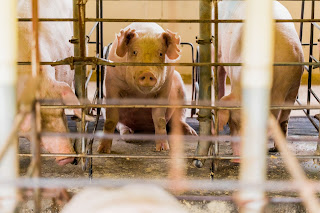The Hidden Realities of Factory Farm Animal Cruelty
Factory farming has become a pervasive practice in the modern agricultural industry, providing a large portion of the world's meat, dairy, and eggs. While it may seem like an efficient way to meet the growing demand for animal products, the dark side of factory farming involves widespread animal cruelty that often goes unnoticed. In this article, we will explore the hidden realities of factory farm animal cruelty and its profound impact on the well-being of animals.
The Living Conditions:
One of the most alarming aspects of factory farming is the
cramped and unsanitary living conditions that animals endure. Cows, pigs,
chickens, and other animals are often confined to tight spaces, where they have
little room to move or exhibit natural behaviors. This confinement leads to
stress, frustration, and the development of various health issues.
Dehorning, debeaking, and tail docking are common practices in
factory farms, performed without anesthesia to prevent injuries in the crowded
living conditions. Factory farm animal cruelty These painful procedures contribute to the overall suffering of the animals, emphasizing the callous nature of factory farming.
Use of Growth Hormones and Antibiotics:
Factory farms often rely on the use of growth hormones and
antibiotics to maximize production and prevent the spread of diseases in
overcrowded conditions. While these substances may enhance productivity, they
pose serious risks to both animal welfare and human health.
Animals injected with growth hormones may experience accelerated
growth, leading to musculoskeletal issues and organ failure. The overuse of
antibiotics in factory farms contributes to the development of
antibiotic-resistant bacteria, posing a significant threat to public health.
Transportation and Slaughter:
The journey from factory farm to slaughterhouse is another
harrowing experience for animals. Transported in overcrowded and poorly
ventilated trucks, animals often endure long journeys without access to food or
water. This transportation process can result in injuries, stress, and even death.
At the slaughterhouse, the methods employed to process animals
can be brutal. Inadequate stunning techniques may leave animals conscious
during slaughter, causing immense pain and distress. The lack of proper
regulation and oversight exacerbates the likelihood of inhumane practices.
Environmental Impact:
Beyond the ethical concerns Factory farm animal cruelty also contributes significantly to environmental degradation. The large-scale production of animal products leads to
deforestation, water pollution, and greenhouse gas emissions. The environmental
impact further emphasizes the need for sustainable and humane alternatives to
factory farming.
Conclusion:
The hidden realities of factory farm animal cruelty shed light
on the urgent need for a more ethical and sustainable approach to food
production. Consumers play a crucial role in driving change by supporting
responsible farming practices and choosing products from sources that
prioritize animal welfare. It is time for society to acknowledge the
consequences of factory farming and work towards a more compassionate and
sustainable future for both animals and the planet.




মন্তব্যসমূহ
একটি মন্তব্য পোস্ট করুন